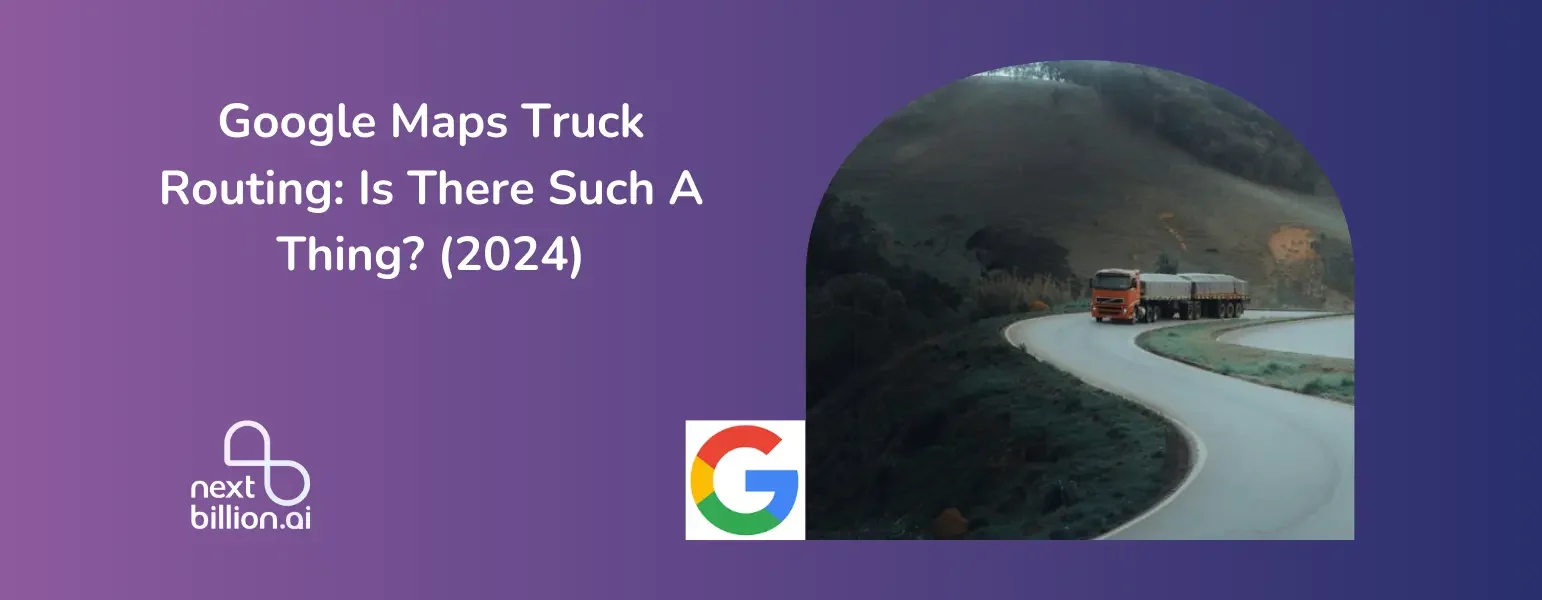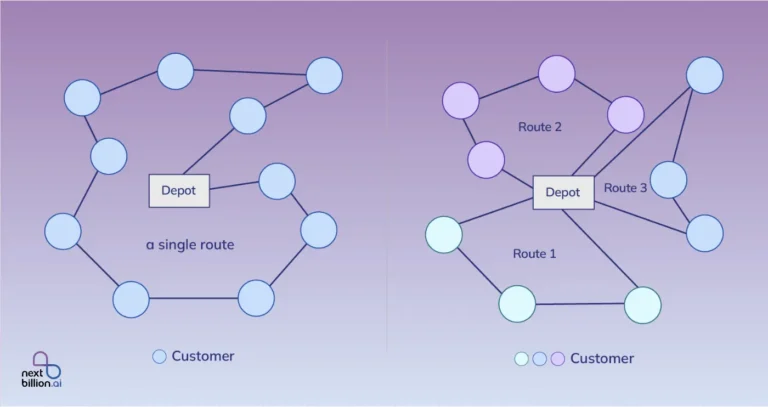
Table of Contents
Google Maps has changed the way we navigate. It’s widely used for everyday commutes, travel planning, and even local exploration. But the question arises: Does Google Maps offer truck-specific routing?
This article aims to dive into this question by examining the current features of Google Maps and its applicability to truck drivers. I’ll explore the limitations and alternatives available for truck routing, providing a comprehensive overview for logistics professionals and truck drivers seeking the most efficient tools for their needs.
What is Truck Routing?
Truck routing refers to the process of planning and optimizing routes specifically for trucks and other large commercial vehicles. Unlike standard routing for passenger vehicles, truck routing takes into account the unique requirements and limitations associated with larger vehicles. This specialized routing ensures that trucks can travel safely and efficiently from one point to another while adhering to regulations and avoiding obstacles that may not affect smaller vehicles.
Truck-specific routing is crucial for several reasons:
Safety: By avoiding low bridges, weight-restricted roads, and other hazards, truck routing helps prevent accidents and damage to infrastructure.
Efficiency: Optimized routes reduce fuel consumption and travel time, leading to cost savings and improved delivery schedules.
Compliance: Ensuring that routes comply with local, state, and federal regulations helps avoid fines and legal issues.
Customer Satisfaction: Timely deliveries and fewer delays contribute to better customer service and satisfaction.
Features of Truck Routing
Effective truck routing involves several key features that address the unique needs of trucks and commercial vehicles:
Weight Limits: Many roads, bridges, and tunnels have weight limits to prevent structural damage and ensure safety. Truck routing software takes these limits into account, directing trucks along routes that can support their weight.
Height Restrictions: Trucks, especially those carrying tall loads or using trailers, must navigate underpasses, bridges, and tunnels with sufficient clearance. Truck routing systems help avoid routes with height restrictions that could pose a risk of collision or damage.
Hazardous Materials Considerations: Certain routes are restricted or off-limits to trucks carrying hazardous materials due to safety and environmental concerns. Truck routing software identifies these restrictions and provides alternative paths that comply with regulations governing the transportation of hazardous materials.
Current State of Google Maps (2025)
Overview of Google Maps’ Features and Capabilities
As of 2025, Google Maps continues to be one of the most widely used navigation and mapping services globally. Known for its user-friendly interface and comprehensive data, Google Maps offers a plethora of features that cater to various user needs. Key capabilities include:
Real-Time Traffic Updates: Google Maps provides real-time traffic information, helping users avoid congestion and find the fastest routes.
Turn-by-Turn Navigation: The app offers detailed turn-by-turn directions for drivers, cyclists, and pedestrians.
Street View: Users can explore streets and landmarks through panoramic photos, providing a virtual tour experience.
Public Transit Information: Google Maps integrates public transit schedules and routes, making it easier for users to plan trips using buses, trains, and subways.
Local Business Information: The platform includes detailed information about local businesses, such as operating hours, reviews, and contact details.
Offline Maps: Users can download maps for offline use, ensuring they have access to navigation even without an internet connection.
General Routing Options Available for Different Vehicle Types
Google Maps offers versatile routing options tailored to different types of vehicles and modes of transportation. Here’s a breakdown of the general routing options available:
Cars: Google Maps provides detailed driving directions with options to avoid tolls, highways, or ferries. The app offers estimated travel times based on real-time traffic data and provides alternative routes to help drivers avoid congestion.
Bikes:For cyclists, Google Maps offers bike-friendly routes that consider bike lanes, paths, and trails. The app highlights elevation changes and suggests the safest and most efficient routes for cycling enthusiasts.
Pedestrians: Pedestrian navigation on Google Maps includes walking directions with detailed turn-by-turn instructions. The app helps users find the quickest paths through parks, pedestrian zones, and sidewalks, ensuring a smooth walking experience.
While Google Maps excels in providing comprehensive routing for cars, bikes, and pedestrians, it has yet to fully integrate truck-specific routing features as of 2025.
This gap presents a challenge for truck drivers who require routing that considers weight limits, height restrictions, and hazardous material regulations. Despite these limitations, Google Maps remains a powerful tool for general navigation and continues to evolve, potentially paving the way for more specialized routing options in the future.
Google Maps’ Evolution and Updates Related to Routing
Since its inception in 2005, Google Maps has undergone significant transformations, continually enhancing its routing and navigation capabilities. Initially focused on providing basic maps and directions for cars, Google Maps gradually expanded to include features like real-time traffic updates, Street View, and integration with public transit systems.
Over the years, Google has made substantial improvements, including the introduction of biking and walking routes, offline maps, and more detailed information about local businesses and points of interest.
Despite these advancements, Google Maps has primarily catered to general-purpose navigation, leaving a gap in the market for specialized routing needs, such as those required by trucks and other large commercial vehicles. While Google has periodically updated its algorithm and database to provide more accurate and efficient routes, truck-specific routing features have not been a primary focus.
Can Google Maps Handle Truck-Specific Routing in 2025?
As of 2025, Google Maps does not offer dedicated truck-specific routing features. While it provides excellent navigation for cars, bikes, and pedestrians, it lacks the necessary tools and data to cater specifically to trucks. Key capabilities missing include:
Weight Limit Considerations: Google Maps does not account for weight restrictions on roads and bridges, which are crucial for trucks carrying heavy loads.
Height Restrictions: The app does not provide alerts for low bridges or tunnels, posing a risk for taller vehicles.
Hazardous Materials Routing: There are no options to plan routes that avoid areas restricted for hazardous materials.
Limitations and Challenges if Truck Routing is Not Available
The absence of truck-specific routing in Google Maps presents several significant challenges:
Safety Risks: Without proper height and weight restrictions, truck drivers risk encountering obstacles that could lead to accidents or damage to infrastructure.
Regulatory Compliance: Truck drivers must adhere to numerous regulations regarding weight limits, hazardous materials, and restricted routes. Google Maps’ lack of these features can result in non-compliance, leading to fines and legal issues.
Inefficiency: Inefficient routes can lead to increased fuel consumption, longer travel times, and higher operational costs. Truck-specific routing would optimize paths, saving time and money.
Driver Frustration: Navigating without specialized routing tools can be frustrating for truck drivers, leading to increased stress and potential delays in deliveries.
Limited Utility: While Google Maps is a powerful tool for general navigation, its limitations make it less useful for the logistics industry, which relies on precise and efficient routing.
In summary, while Google Maps remains a highly versatile and widely used navigation tool, its current capabilities fall short for the specific needs of truck routing in 2025.
This gap highlights the importance of exploring alternative solutions that cater specifically to the trucking industry, ensuring safety, compliance, and efficiency in commercial transportation.
Alternative Solutions to Google Maps Truck Google Maps and Truck Routing
While Google Maps excels in providing general navigation, it falls short in addressing the specific needs of the trucking industry. Fortunately, several specialized truck routing apps and software solutions are available that cater specifically to the unique requirements of commercial vehicles. One of the most prominent among these is NextBillion.ai.
NextBillion.ai: Tailored Solutions for the Trucking Industry
NextBillion.ai is a comprehensive routing solution designed to address the challenges faced by the trucking industry. It offers features tailored to optimize trucking operations, ensuring safety, compliance, and efficiency. Here are some key features of NextBillion.ai:
Regulation-Compliant Routes: Generates routes adhering to trucking regulations, considering factors like truck dimensions and hazardous materials restrictions.
Ensures safe and legal transit by avoiding restricted areas.
Hours of Service (HOS) Compliance: Designs long-haul routes with built-in schedules and breaks to comply with HOS regulations.
Maintains compliance with rules governing maximum driving hours and rest periods.
Toll and Toll-Free Route Selection: Offers flexibility in route planning to include or avoid tolls, ferries, tunnels, and highways based on operational needs.
Enables cost minimization and route optimization according to specific business objectives.
Optimization with Multiple Constraints: Utilizes over 50 constraints to optimize routes for multi-location scenarios, including recurring and last-minute changes.
Enhances efficiency in forward and reverse logistics, optimizing loads based on volume and truckload scenarios.
Integration with Telematics Solutions: Integrates with existing telematics solutions for live tracking and instant alerts.
Enhances visibility into fleet operations and facilitates proactive management.
Mileage and Speed Limit Violation Reporting: Provides detailed mileage breakdowns for compliance, invoicing, reimbursement, and taxation purposes.
Monitors speed limit violations, allowing businesses to enhance road safety and monitor driver behavior.
Solutions Across Various Use Cases: Caters to diverse trucking use cases, including first, middle, and last mile logistics, B2B deliveries, and reverse logistics.
Simplifies multi-route and multi-stop planning, handling large-scale recurring deliveries, and finding cost-efficient return routes.
Comparison of Features with Google Maps
Feature | Google Maps | NextBillion.ai |
General Navigation | Excellent for cars, bikes, and pedestrians. | Offers routes for various vehicle profiles. Tailored routes considering truck dimensions, weight, and hazardous materials. |
Real-Time Traffic Updates | Provides current traffic conditions and alternative routes. | Ensures adherence to trucking regulations, including HOS compliance. |
Street View and Offline Maps | Offers comprehensive visual navigation and offline accessibility. | Advanced optimization with multiple constraints and toll preferences. |
Business Information | Detailed local business information and public transit integration. | Real-time fleet monitoring and alerts through seamless telematics integration. |
Truck-Specific Routing | Not specified. | Tailored routes considering truck dimensions, weight, and hazardous materials. |
Regulation Compliance | Not specified. | Ensures adherence to trucking regulations, including HOS compliance. |
Route Optimization | Basic route planning. | Advanced optimization with multiple constraints and toll preferences. |
Telematics Integration | Not specified. | Real-time fleet monitoring and alerts through seamless telematics integration. |
Comprehensive Reporting | Not specified. | Detailed mileage and speed limit violation reports for compliance and operational insights. |
Multi-Use Case Solutions | General use for navigation across various transport modes. | Versatile applications across various logistics scenarios. |
Pros and Cons of Using Specialized Truck Routing Solutions
✅Enhanced Safety: Specialized routing ensures adherence to weight limits, height restrictions, and hazardous materials regulations, reducing the risk of accidents.
✅Regulatory Compliance: Automatic compliance with trucking regulations, avoiding fines and legal issues.
✅Operational Efficiency: Optimized routes save time and fuel, reducing operational costs and improving delivery times.
✅Driver Satisfaction: Reduced stress for drivers with safer, more efficient routes and compliance with rest period regulations.
✅Comprehensive Monitoring: Integration with telematics provides real-time tracking and fleet management, enhancing transparency and responsiveness.
❌Cost: Specialized truck routing software may involve additional costs compared to free services like Google Maps.
❌Complexity: Implementing and integrating advanced features may require technical expertise and training.
❌Limited General Use: While excellent for truck-specific needs, these solutions might not be as versatile for general navigation purposes.
In conclusion, while Google Maps remains a powerful tool for general navigation, specialized truck routing solutions like NextBillion.ai provide essential features tailored to the trucking industry’s unique needs. These solutions ensure safety, compliance, and efficiency, making them indispensable for modern logistics and transportation operations.
Case Studies and Real-world Applications
A B2B Trucking Logistics Startup Improves Cost Estimation
The startup’s app allowed users to quickly book on-demand trucks, specifying the type of truck and receiving pricing details upfront. Accurate and robust distance calculations were crucial for this functionality. Additionally, they needed to offer live location tracking as soon as a booking was made.
Beyond just trucking, the startup aimed to become an “AirBnB for warehouses” and an “Amazon marketplace for truckers,” requiring a comprehensive network of accessible warehouses and repair stations. They also needed accurate and fast performance services to help truckers locate fuel stations, repair shops, and accessory stores.
Our Solution
To address these challenges, the startup evaluated NextBillion.ai’s large Distance Matrix API. They needed to generate optimized routes and provide accurate cost estimates upfront for customers, along with live tracking and visibility.
After evaluating various mapping service providers, the startup chose NextBillion.ai for several reasons:
Accurate Cost Estimation: NextBillion.ai’s Distance Matrix API supported larger matrix sizes (5000×5000 compared to the standard 25×25), enabling the startup to scale easily without size limitations and calculate precise transportation costs.
Optimized Routing: The API allowed the startup to generate optimized routes, accounting for additional fleets and unplanned stops.
Real-Time Tracking: NextBillion.ai provided the capability to track delivery trucks in real-time, enhancing customer experience and operational efficiency.
The Outcome
By leveraging NextBillion.ai’s solutions, the startup achieved significant improvements:
Streamlined Operations: The large Distance Matrix API facilitated quick and accurate price calculations, optimizing truck dispatch and response times.
Enhanced Network: The startup could identify and navigate to warehouses and repair stops more effectively.
Real-Time Tracking: Customers could now view trucks carrying goods in real-time, increasing transparency and trust.
Cost Efficiency: NextBillion.ai offered a cost-effective solution compared to competitors, contributing to overall operational savings.
Truck Logistics Solution Provider Achieves Sustainable Growth and Slashes Costs by 30%
The Problem
The startup initially used a distance matrix API to calculate distances and ETAs for their fleet. However, they encountered significant issues:
1. Excessive Cost: The API’s fixed pricing model proved too costly due to the high volume of API calls—millions of calls and tens of millions of distance matrix elements each month.
2. Future Threat: The inflexible pricing model posed a risk for the early-stage company, as unpredictable growth and usage patterns could lead to skyrocketing costs during periods of high usage.
Recognizing that their existing API was unsuitable, the client sought an alternative that met the following criteria:
- Cost efficiency
- Cost predictability
- Room for operational growth
- Fast API response times
They soon discovered NextBillion.ai’s Distance Matrix API.
The Solution
Upon evaluating the client’s needs, it was clear that NextBillion.ai’s Distance Matrix API was a perfect fit. Here’s why:
1. Scalability: While most APIs offer a 25×25 matrix size, NextBillion.ai supports matrices up to 5,000×5,000 elements. This capability allows the client to calculate ETAs and distances between 5,000 origins and 5,000 destinations in a single call, providing confidence in the API’s ability to scale with their growth.
2. Truck Profiles: Unlike the existing solution, NextBillion.ai’s API includes truck profiles, enabling optimized truck-specific routing. The system accounts for variables such as truck dimensions, weight, and cargo type for efficient and regulation-compliant routes.
3. Customized Pricing: Flexibility in pricing was crucial. NextBillion.ai offered a customized asset-based pricing model that allowed the client to predict costs accurately based on the number of trucks used each month.
4. Low Latency: Speed was essential due to the large number of API calls and potential for rapid business expansion. NextBillion.ai’s low-latency API ensured quick responses, meeting time-sensitive requirements.
5. Ease of Integration: The API’s ease of implementation meant that the client could integrate it without overhauling their existing infrastructure. With minimal coding, they had the system up and running swiftly.
Conclusion
Google Maps, while excellent for personal navigation and general use, is not a viable solution for truck routing in 2025. The absence of truck-specific routing features means that it cannot adequately address the unique requirements of the trucking industry.
Relying on Google Maps for truck logistics can result in suboptimal routes, increased fuel costs, and potential legal complications due to non-compliance with road regulations. As a result, logistics companies and truck drivers need more specialized tools designed to handle the complexities of truck routing.
About Author
Rishabh Singh
Rishabh Singh is a Freelance Technical Writer at NextBillion.ai. He specializes in Programming, Data analytics and technical consulting, turning complex tech into clear and engaging content.







